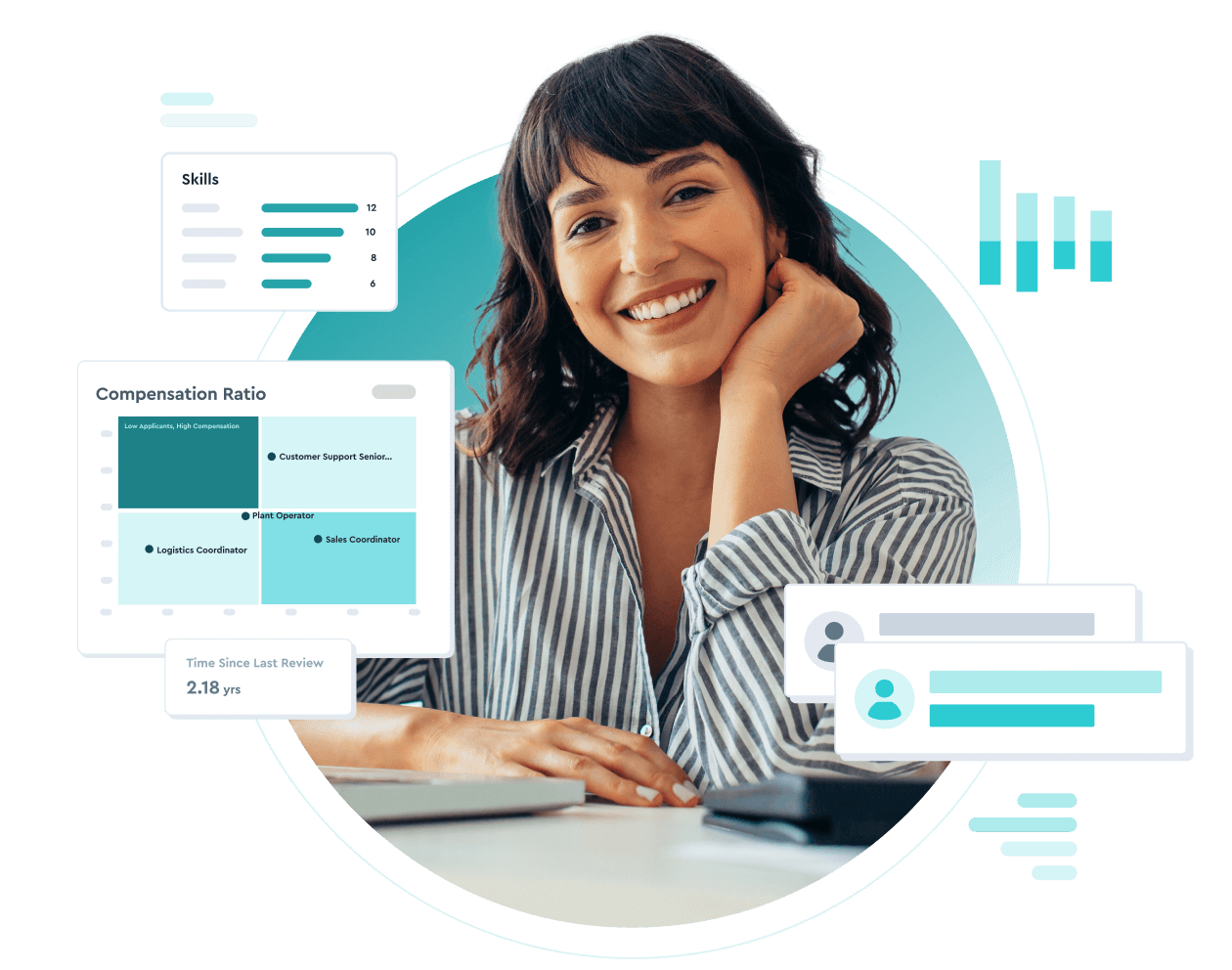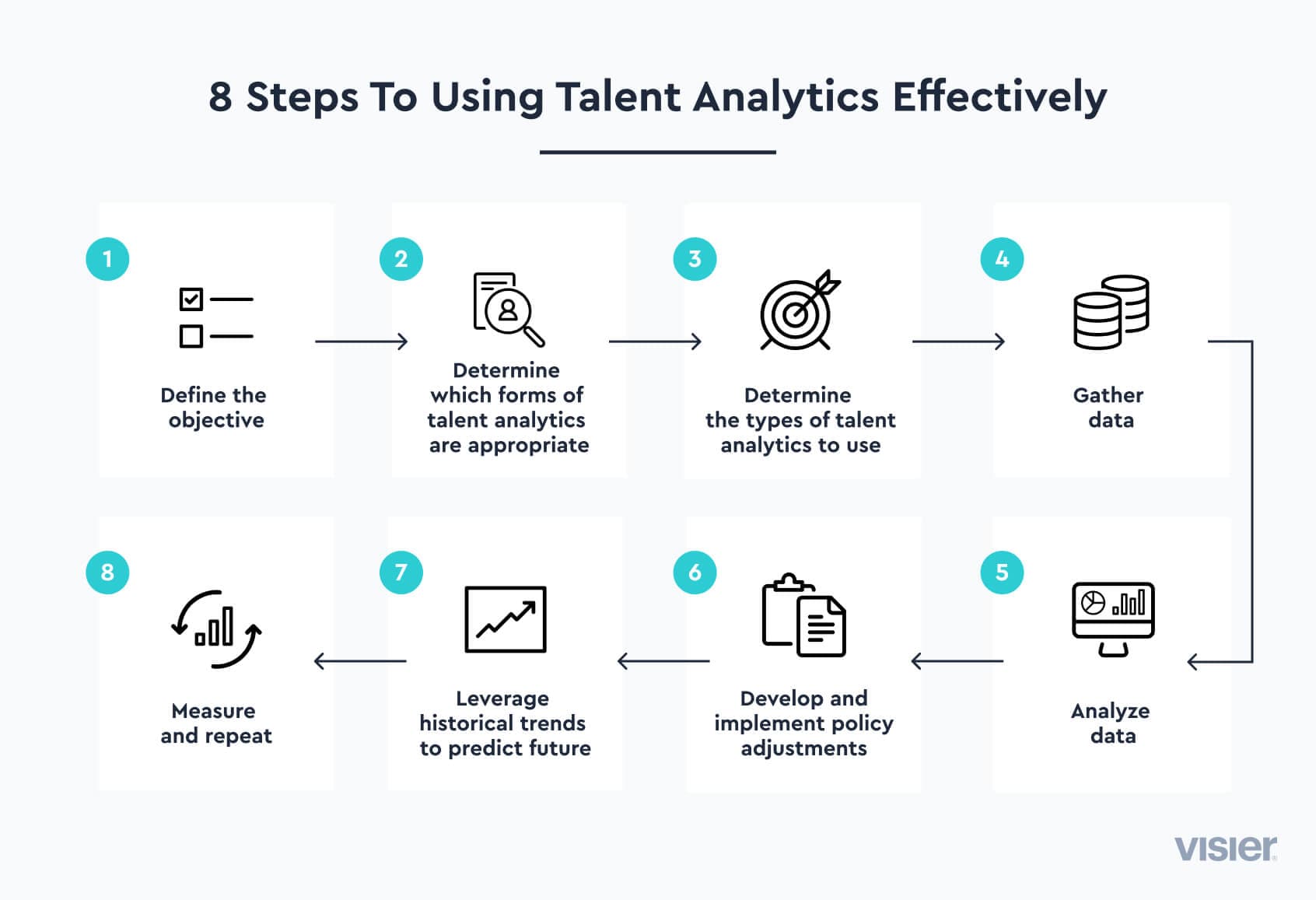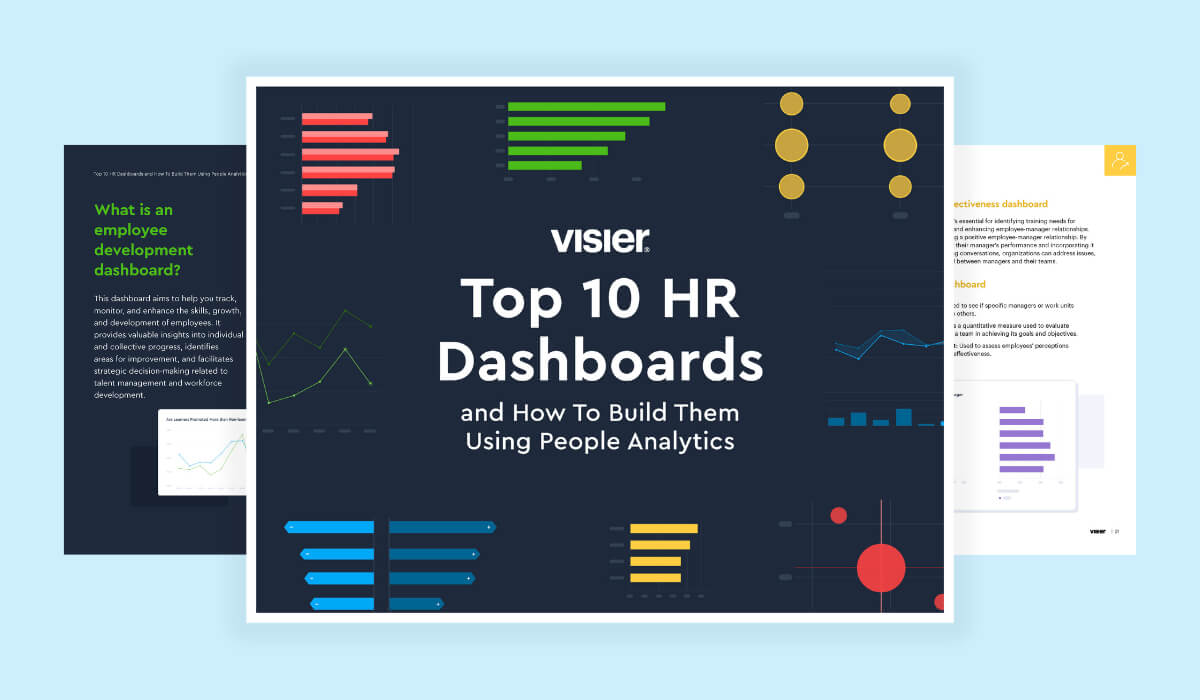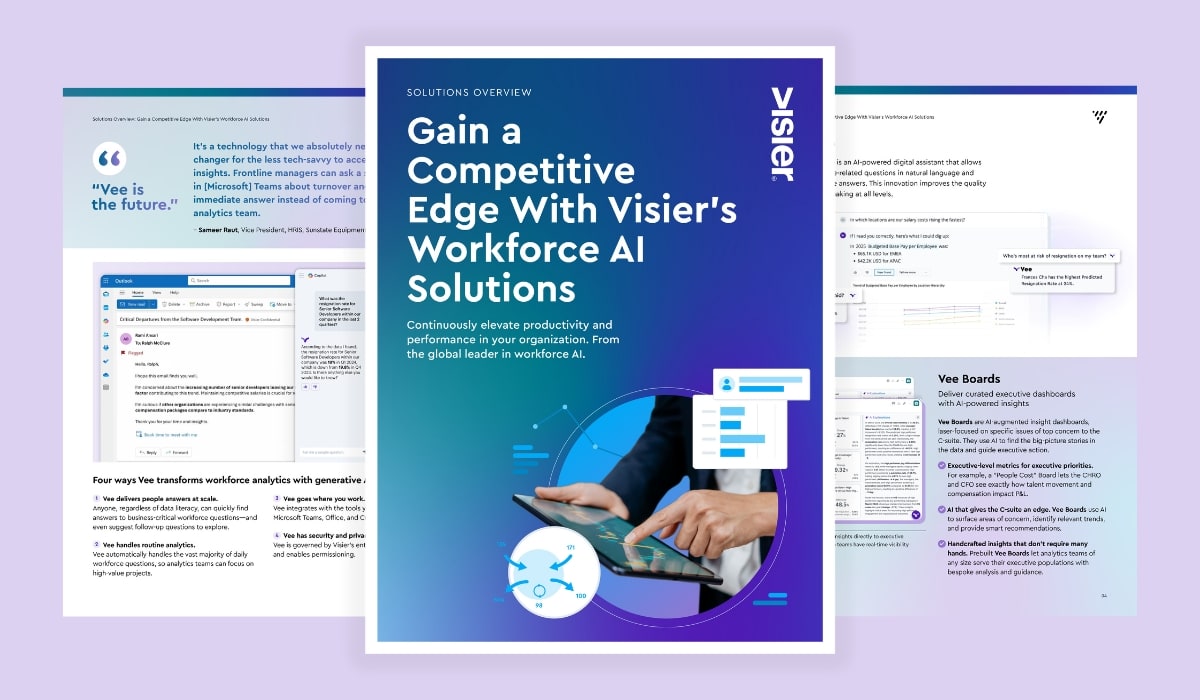HR Analytics
Leveraging Talent Analytics to Make Better People Decisions
Talent analytics is a statistical methodology for collecting, analyzing and acting on organizational data. Learn how to use it—and the benefits—below.
Explore talent analytics
Table of contents
What are talent analytics?Pros and cons of talent analyticsThe process for using talent analytics effectively Examples of talent analyticsUse the right tools to fuel your talent analytics strategyWhat are talent analytics?
Talent analytics, sometimes referred to as “people analytics,” is a data-driven methodology for making human resources decisions about the current and potential future workforce of an organization. It involves collecting and transforming HR and organizational data into actionable insights to improve business results. Talent analytics relies heavily on statistical concepts and tools to make sense of what are often large volumes of data—or “big data.”
Information-based economies thrive on talent metrics
In recent decades, organizations have increasingly embraced the concept of people as their greatest asset. In an information-based economy, having sufficient numbers of capable employees is essential to succeeding in highly competitive markets.
At the same time, an information-based economy also requires a decidedly non-human input: data. Companies spend huge sums of money acquiring, storing, and analyzing massive amounts of data to help them make sense of the world of today and plan for the world of tomorrow.
Technology and talent analytics
Talent analytics is the result of these two critical components of the information economy supporting one another. There are all kinds of data that can help organizations better understand their current talent resources and needs. However, it can be prohibitively time-consuming for humans to manually process all the desired data inputs.
Talent analytics relies on increasingly sophisticated statistical models and computers to handle the number crunching, while leaving the higher-level analysis and data-driven decision-making to the humans.
Types of talent analytics
Talent analytics can take on several forms depending on the underlying objective. Common types of talent analytics include the following.
1. Descriptive
Descriptive analytics is typically the easiest form of analytics. Organizations would use talent analytics to better understand the current state of affairs. For example:
How many part-time versus full-time versus contract employees does the organization employ?
What percentage of managers have a graduate-level degree or higher?
What percentage of staff voluntarily left the organization last year?
Descriptive analytics tend to be relatively straightforward. It doesn’t require making assumptions about, or predictions of, future events. The information desired actually exists today. All that’s required is collecting and analyzing the data.
2. Diagnostic
Diagnostic analytics looks at the current state of affairs as described by descriptive analytics and attempts to explain why that current state exists.
Why don’t we have more managers with masters degrees?
Why did so many staff quit last year?
Why are so many new employees leaving within a year of being hired?
In other words, diagnostic analytics helps to diagnose—and respond to—the root cause of a specific issue using real data and analytics.
3. Predictive
Predictive analytics is a bit trickier than descriptive analytics, and has a more forward-looking focus. Its goal is to foresee, or predict, the future state of a department or organization. Predictive analytics can also be used to predict what will happen with respect to individual employees or the broader industry or market within which an organization operates.
For example, an organization might use predictive talent analytics to estimate the number of key staff who will leave the company over the next five years.
4. Prescriptive
Being able to predict the future is great, as long as you can do something with that foresight. Prescriptive analytics involves taking one’s best prediction about the future, along with observations about the past and current state of affairs, and suggesting a course of action for the future.
For example, the organization conducting the hypothetical analysis of key staff attrition in the prescriptive talent analytics example above might decide, based on a prescriptive analysis, that it needs to immediately start developing internal talent to fill key roles likely at risk according to the predicted attrition.
Talent analytics data can come from a variety of sources including:
Social media
Job boards
Applicant tracking systems
Candidate relationship management
Employee engagement and satisfaction data
Combining and comparing data can help organizations draw conclusions and identify causes and correlations.

Pros and cons of talent analytics
Talent analytics can be a powerful tool for any organization when used effectively. It’s important to note, however, that talent analytics can turn into an inefficient waste of resources or even steer an organization in the wrong direction if not performed properly.
Here are a few pros and cons of talent analytics businesses should consider before diving in.
Pros of talent analytics
Talent analytics is a powerful methodology that unlocks objective decision-making around real workforce data. The pros of talent analytics, therefore, are as follows.
Better-informed decision making
One of the most obvious objectives with any talent analytics project is the ability to make better-informed decisions about talent management.
Understanding the world in which the business operates today as well as expectations for the future is essential for planning. Sound decision-making is not guaranteed by talent analytics, however. As we’ll discuss below, there are many challenges that can hinder or derail a talent analytics project.
New insights
Companies are often surprised by the results of their descriptive talent analytics. Analyzing this data can help identify long-standing false assumptions the organization was operating under. This analysis can also identify hidden opportunities.
Ability to tie outcomes to policy choices
There is a great deal that is beyond the direct control of any business. However, negative outcomes aren’t always simply due to bad luck. Diagnostic analytics can help companies connect the dots between results (whether good or bad) and the underlying policy choices that contributed to those results.
Better overall results
Not all talent analytics efforts are created equal. Companies that engage in well-conceived and well-executed talent analytics efforts do better than their non-analytical competitors on factors like employee satisfaction, turnover, talent development, and more.
The effective use of talent analytics can help companies reap rewards across the entire employee life cycle.

Cons of talent analytics
Despite the many benefits, or pros, of talent analytics, talent analytics can have some drawbacks which are important to address. The good news is that, generally, these “cons” can be avoided by careful and well-informed planning when designing a talent analytics program.
Some cons of talent analytics include the following.
Legal risks
It’s important for businesses to be aware of potential legal and regulatory rules that prohibit collecting and acting on certain types of talent data, particularly personal data.
When collecting data on employees, it’s important to do so in consultation with data privacy, legal, and HR teams to ensure compliance with national, state, and local laws and regulations.
Impersonal
One of the great strengths of talent analytics is the ability to compare apples to apples across a large number of individuals. The other side of this coin, however, is that talent analytics is inherently impersonal.
Employees, as individuals, generally can not be compared apples to apples to their colleagues. Care must be taken to not ignore the individual aspects of employees when focusing on objective metrics that are being applied broadly.
Data overload
The term “big data” tends to be used as a positive concept. But while massive amounts of data can provide the potential to arrive at great insights, all that data can also be overwhelming and confusing if a talent analytics project is not properly thought out. It’s important to focus on collecting and analyzing data that is “need to know,” not just “nice to know.”
Faulty conclusions
Even sound data can lead to faulty conclusions, unfortunately. There can be a tendency among those conducting talent analytics projects to assume that conclusions based on sound data must be sound. This is not always the case. That’s a key reason to conduct post-action diagnostic analyses when basing policy decisions on prescriptive analytics.
The process for using talent analytics effectively

The general process for using talent analytics is relatively straightforward. The devil, though, as they say, is often in the details. Here are some important steps for ensuring that talent analytics are used effectively to drive sound, data-driven decisions.
1. Define the objective
Talent analytics doesn’t have to be conducted with an end goal of making significant organizational changes, but it does need to have some goal in mind.
Again, this could be as simple as a descriptive talent analysis to get an idea of the current state of the company’s workforce. Not having an objective in mind is a recipe for getting overwhelmed with data that may or may not be relevant.
2. Build a talent analytics team
Talent analytics shouldn’t be owned by a single individual. It takes a dedicated team to develop and use talent analytics strategically and effectively. That team can include people from areas like IT, HR, legal, etc., from senior leaders on down to line staff members.
3. Determine which forms of talent analytics are appropriate
Based on established objectives, the next step is to determine which forms of talent analytics may be appropriate for each outcome desired: descriptive, diagnostic, predictive, or prescriptive.
4. Define the relevant metrics
Data analysis requires creating some metrics that can support an apples-to-apples comparison of data. These metrics might include things like number of employees, self-reported employee satisfaction (on a 1 – 10 scale), employee productivity, and others.
5. Gather data
Talent analytics metrics should be designed based on data inputs that are readily accessible. In some cases, data might already exist. In other cases, new methods of capturing data must be developed. Decisions about the cost/benefit of gathering new data should be tied back to objectives, again based on a “need to know.”
6. Analyze data
Once the requisite data has been gathered, the data will need to be analyzed and interpreted. The process and additional tools you use for data analysis will depend on the amount of data collected, and the complexity of the analysis required.
7. Develop and implement policy adjustments
Talent analytics data gathered will yield insights that may drive changes in policies or practices. For instance, if data is indicating that new employees are leaving within a year of hire, that might require additional investigation to determine the “why” behind the numbers. Then, actions would need to be taken to make adjustments to policies or practices that might be driving turnover.
8. Measure and repeat
The talent analytics process is iterative. Both the internal and external environment change, new business strategies are implemented, and new people strategies need to follow suit. In addition, results will ebb and flow so it’s important to continually track the numbers so course corrections can be made as necessary.
Examples of talent analytics

We’ve provided some examples of talent analytics throughout this article. Here are some additional examples of talent analytics that companies might focus on to drive desired business results.
Descriptive: “What are the current levels of employee satisfaction and engagement?”
Diagnostic: “Why have employee satisfaction and engagement fallen over the past year?”
Predictive: “Would modifying the company’s incentive structure increase employee satisfaction and engagement in the future?”
Prescriptive: “Should we increase employee bonuses and switch from an annual to a quarterly bonus program to improve employee satisfaction and engagement?”
Standard Bank Group used people analytics to identify the company value drivers of client focus, employee engagement, risk and conduct, operational excellence, and C-suite financial outcomes. The people analytics team identified leadership effectiveness as a key to driving these desired results. Ultimately, the company developed leadership scorecards tied to senior leaders’ annual performance reviews.
Reech Group used talent analytics to make better talent, recruiting, and training decisions. As their Chief People Experience Officer, Sally Young, said: “Once leaders can see that people analytics is applicable to solving their problems, they use it, which in turn helps build their capabilities as strategic people leaders.”
Many companies also are using workforce analytics to improve their diversity, equity, and inclusion (DEI) performance.
Broadly, talent analytics can help organizations improve their talent management processes to maximize employee satisfaction, engagement, performance, and retention.
Use the right tools to fuel your talent analytics strategy
Talent analytics sits at the intersection between people and big data. It uses data and computing power to help make sense of an organization's human capital, and to drive strategic change. While many organizations have brilliant leaders capable of making sound talent management decisions given the right information, it’s often a challenge to make sense of massive volumes of data—especially when it comes from different sources, and says different things.
This is where having the right talent analytics tools in place can help. Employee satisfaction tools, for example, can help identify key benchmark data, and uncover underlying problems, trends, and opportunities. Strategic compensation tools can keep tabs on employee compensation levels to ensure they’re commensurate with employee performance, and inline with the market. Talent pathway and managers’ tools can help to identify top performers on a team, map a desirable career pathway for them, and place them in positions of greater influence.



